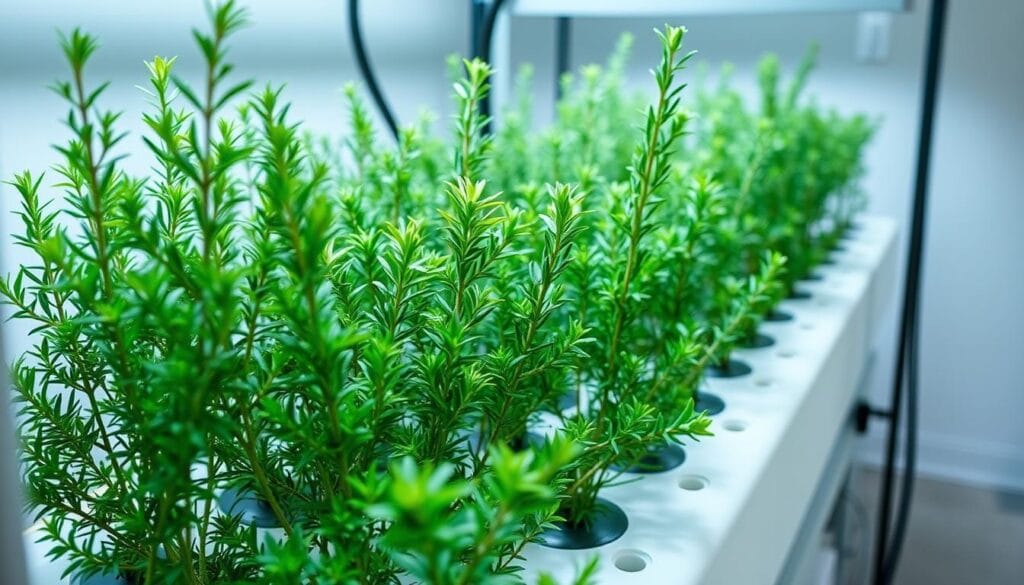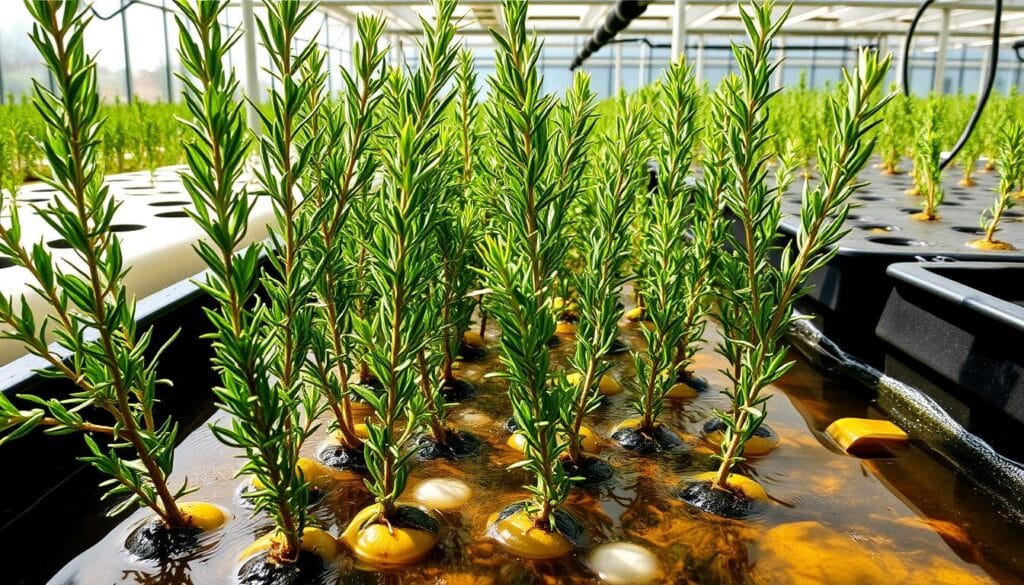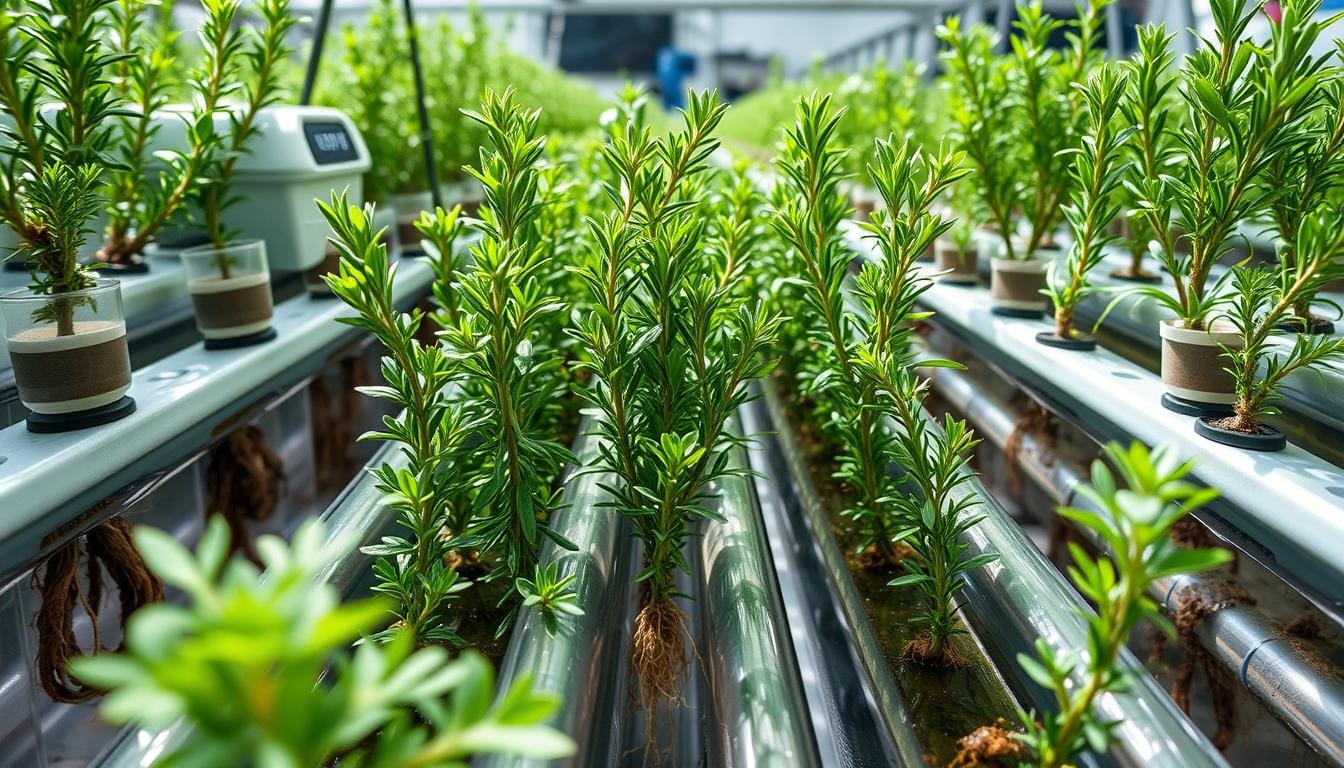How Long Does Rosemary Take to Sprout Perfectly in Hydroponics? If you’re passionate about gardening and want to grow herbs like rosemary in a hydroponic system, you’ve come to the right place. Growing rosemary without soil is not only exciting but also incredibly rewarding. In this post, I’ll share what I’ve learned to help you succeed with hydroponic rosemary cultivation.
Key Takeaways
- Rosemary seeds typically germinate in 15-30 days under ideal hydroponic conditions.
- Hydroponic systems offer better control over temperature, humidity, and lighting to speed up rosemary germination.
- Ensuring proper seed preparation, nutrient balance, and water quality monitoring is vital for successful rosemary sprouting.
- Understanding rosemary’s unique growing requirements is key to a thriving hydroponic setup.
- With the right strategies, you can enjoy the aromatic benefits of freshly grown rosemary year-round, even in winter.
Understanding Rosemary’s Growth Characteristics
Rosemary originates from the Mediterranean region and thrives in warm, dry environments. To grow it well in hydroponics, knowing its growth patterns and needs is key.
Mediterranean Origins and Natural Habitat
Rosemary grows best in the Mediterranean’s sunny weather. It needs 6-8 hours of bright, direct sunlight each day to thrive. It also prefers temperatures between 65°F and 75°F (18°C to 24°C). To successfully grow rosemary in hydroponics, it’s essential to replicate these warm and dry conditions.
Growth Patterns in Hydroponic Systems
Hydroponics save a lot of water, up to 90% less than soil gardening. Rosemary flourishes in dry environments and thrives in well-draining media like perlite or coco coir. This keeps the plant’s moisture right.
Basic Growth Requirements
The growing medium’s pH should be 5.5 to 6.5 for rosemary. The nutrient solution’s EC should be 1.0 to 1.6 mS/cm. This guarantees the plant receives the essential nutrients it needs.
| Nutrient | Optimal Concentration Range |
|---|---|
| Nitrogen (N) | 150-200 ppm |
| Phosphorus (P) | 31-50 ppm |
| Potassium (K) | 210-280 ppm |
| Calcium (Ca) | 150-200 ppm |
| Magnesium (Mg) | 50-70 ppm |
Knowing Rosemary’s growth habits and following these conditions helps. This way, you can successfully grow rosemary hydroponically and enjoy a good harvest.
Essential Hydroponic Setup for Rosemary Cultivation
Starting a hydroponic system for indoor rosemary cultivation is easy and can lead to great results. You’ll need a reservoir for the nutrient solution, a pump to move the water, and an airstone for root oxygen.
The growing container should be 12 inches in diameter to support rosemary’s strong roots. Popular methods like ebb and flow, deep water culture (DWC), or nutrient film technique (NFT) work well for rosemary care.
- Ebb and flow systems mimic natural soil conditions by flooding and draining the growing tray with water.
- DWC keeps roots in a constantly aerated solution for fast growth.
- NFT provides a steady flow of nutrients and oxygen over the roots.
Proper drainage and aeration are crucial to preventing root rot and promoting efficient nutrient absorption. Regular upkeep, like cleaning every two weeks, keeps your indoor rosemary healthy.
“Hydroponic systems consume over 90% less water than traditional soil-based farming methods.”
While starting a hydroponic system costs more than traditional gardening, its long-term benefits are worth it. Hydroponic plants absorb nutrients better, grow faster, and produce more.
How Long Does Rosemary Take to Sprout Perfectly in Hydroponics
Growing rosemary in hydroponics can take about 2 to 3 weeks to sprout. This Mediterranean herb does well in hydroponics because it needs little care. It thrives in controlled environments.
Germination Timeline Overview
Rosemary seeds can start germinating in as little as 14 days. But, 20 days is more common. Many things can affect how fast they sprout, so watch them closely.
Factors Affecting Sprouting Speed
Several things can change how fast rosemary sprouts in hydroponics. These include:
- Temperature: Rosemary grows best at about 70°F (21°C).
- Light exposure: It requires at least 5 hours of direct sunlight daily and a DLI (Daily Light Integral) of 15+ mol/m²/day for optimal growth.
- Seed quality: Using fresh, high-quality seeds helps a lot.
- Nutrient solution: The right nutrients in the solution help seeds grow fast and strong.
Signs of Successful Germination
When you see a small white taproot and the first true leaves, it’s a sign of success. These signs mean your plants are growing well in your hydroponic setup.
Knowing about germination times and what affects them helps your rosemary plants start strong. This sets them up for a great harvest later on.
Optimal Growing Conditions for Successful Sprouting
To get your rosemary seeds to sprout well, focus on temperature, lighting, humidity, and nutrients. This will help your herb garden and hydroponic herbs grow strong.
Rosemary loves temperatures between 65°F and 75°F (18°C to 24°C). It needs 6-8 hours of direct sunlight or 12-16 hours of artificial light each day. Keep the humidity between 40% and 60% to avoid drying or mold.
For nutrients, use a balanced hydroponic fertilizer with an EC of 1.0 to 1.6 mS/cm. Check and adjust the pH levels often. Keep them between 5.5 and 6.5 for the best nutrient uptake by your rosemary.
| Condition | Optimal Range |
|---|---|
| Temperature | 65°F – 75°F (18°C – 24°C) |
| Lighting | 6-8 hours of direct sunlight or 12-16 hours of artificial light |
| Humidity | 40% – 60% |
| Nutrient EC | 1.0 – 1.6 mS/cm |
| pH | 5.5 – 6.5 |
By watching and adjusting these important factors, you can make a great growing space. This will help your rosemary seeds sprout and grow well in your hydroponic herb garden.

Seed Preparation and Treatment Methods
When starting rosemary seed propagation in a hydroponic system, getting the seeds ready is key. Here are some tips to help your rosemary seedlings grow well from the start.
Pre-germination Techniques
To get your rosemary seeds to sprout fast and evenly, try pre-germination methods. Stratification is one method. This process requires chilling the seeds for 3-4 weeks. This simulates the winter they’d experience in their natural habitat, starting the germination process.
Scarification is another technique. This means making minor abrasions or cuts on the outer seed layer. This helps the seed absorb water better and germinate faster.
Proper Storage and Handling
Keeping your rosemary seeds in good condition is vital for hydroponic rosemary care. Store them in a cool, dry spot, like an airtight container in the fridge. Store them in a cool, dry, and dark place to protect them from heat, moisture, and sunlight, preventing any potential damage.
Quality Selection Criteria
Choosing the right rosemary seeds is important. Look for seeds from trusted sources. They should be certified, disease-free, and have a good germination rate. Don’t buy cheap or unknown seeds, as they might not work well in your system.
By using these seed preparation and treatment tips, you’ll be ready to grow healthy rosemary seed propagation in your hydroponic setup. With proper care, your rosemary plants will flourish, leading to a great harvest later.
Nutrient Solution Management for Rosemary Seeds
For hydroponic rosemary, managing your nutrient solution is key. You need a balanced fertilizer for herbs or Mediterranean plants. This supports your seedlings’ growth.
Keep your solution’s electrical conductivity (EC) between 1.0 and 1.6 mS/cm. As your plants grow, you can slowly increase the EC. Also, adjust the pH to 5.5-6.5 for better nutrient uptake in your rosemary hydroponics setup.
Changing the solution weekly and flushing every 2-3 weeks is crucial. This prevents salt buildup. Rosemary needs more potassium and calcium, especially when it flowers. So, keep an eye on these nutrient levels.
Here are the target nutrient ranges:
- Nitrogen (N): 150-200 ppm
- Phosphorus (P): 31-50 ppm
- Potassium (K): 210-280 ppm
- Calcium (Ca): 150-200 ppm
- Magnesium (Mg): 50-70 ppm
By monitoring and managing your nutrient solution, you create a perfect environment. Your hydroponic rosemary will thrive and give you plenty of flavorful harvests.

Common Sprouting Challenges and Solutions
Cultivating rosemary hydroponically is highly rewarding but does come with its challenges. Knowing how to tackle common issues is key to a successful harvest. Let’s look at some common problems and how to solve them to help your hydroponic rosemary grow well.
Temperature-Related Issues
Rosemary seeds need a temperature between 65°F and 75°F (18°C to 24°C) to germinate well. Temperature changes can slow down or stop sprouting. Keep the area stable with a grow light or a warm, bright spot.
Humidity Control Problems
Too much humidity can cause fungal growth, harming your seedlings. Make sure there’s good airflow around your hydroponic setup. Use a humidity dome or vent to keep humidity between 40-60%.
Nutrient Deficiencies
Rosemary can lack nutrients, leading to slow growth or leaf discoloration. Check your hydroponic system’s nutrient solution often. Adjust it as needed to give your rosemary the nutrients it needs.
By tackling these common issues and using the right solutions, you can create a great environment for your hydroponic rosemary. With proper care, growing rosemary hydroponically can be rewarding and successful.
Hydroponic gardening is a great way to grow herbs like rosemary all year. It’s perfect for both new and experienced gardeners because it’s efficient and eco-friendly.
Transitioning Sprouted Rosemary to the Growing Phase
Congratulations! Your rosemary seedlings have sprouted, marking the beginning of an exciting journey. Now, it’s time to give them the right care and environment for growth. Let’s look at how to help your hydroponic rosemary thrive.
When your rosemary seedlings get their first true leaves, it’s time to adjust their care. Start by reducing humidity and increasing light exposure slowly. This allows them to adapt smoothly to their new environment. Also, remove weaker seedlings to focus nutrients on the strongest ones.
As your rosemary grows, slowly increase the nutrient solution’s strength. This supplies them with the vital nutrients necessary for healthy development. Make sure to space plants well to prevent overcrowding and pests.
When your rosemary is 6-8 inches tall, it’s time to prune. Pruning encourages bushy growth and keeps your rosemary looking good. Keep an eye on the roots and transplant them if needed to support their growth.
By following these steps, you’ll move your rosemary from the sprouting to the growing phase. This sets the stage for a successful rosemary hydroponics harvest. Remember, consistent care and flexibility are crucial for your hydroponic rosemary care success.
Conclusion
Rosemary sprouts in hydroponics in 15-30 days with the right care. Knowing what affects rosemary sprouting helps gardeners get the most from this herb.
Keeping the right temperature, humidity, and light is key for fast and healthy sprouting. Quality seeds and good nutrient management are also important. With care and patience, you can grow thriving rosemary plants all year in your hydroponic garden.
These tips are great for both new and experienced hydroponic gardeners. They help you grow rosemary successfully. You’ll enjoy a rich harvest of flavorful herbs to use in cooking or making herbal remedies.

